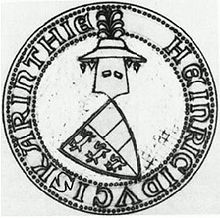Heinrich of Carinthia
Heinrich von Kärnten ( Jindřich Korutanský , * 1265 (other sources speak of 1273 or 1280), † April 2, 1335 in Castle Tyrol , Tyrol ) was a prince from the Meinhardin dynasty. From 1307 to 1310 he was King of Bohemia and Margrave of Moravia as well as Titular King of Poland . In addition, Heinrich was from 1310 until his death as Heinrich VI. Duke of Carinthia and Carniola and Count of Tyrol .
Life
Heinrich was the son of the Carinthian Duke Meinhard II of Görz-Tirol and Elisabeth of Bavaria , a daughter of Duke Otto II. When Heinrich VI. After the death of his father, he took over the reign in Carinthia and Tyrol together with his brothers . Since he supported his Habsburg brother-in-law Albrecht I in the battle of Göllheim in 1298, he received from this imperial fief .
After the murder of Wenceslas (1306) and the death of Albrecht's son Rudolf (1307), he was elected King of Bohemia on August 15, 1307 against the resistance of the Habsburgs (based on his inheritance claims as a result of his marriage to Anna , the eldest sister of King Wenceslas III. Of Bohemia).
His rule soon aroused resistance in Bohemia, and in 1309/10 his opponents made contact with the Roman-German King Henry VII . In July 1310 Heinrich of Carinthia was withdrawn from his fief and at the end of August 1310 the son of Henry VII, Johann von Luxemburg , was enfeoffed with the kingdom. At the end of the year, troops under Johann's leadership occupied Bohemia, Heinrich von Kärnten had to withdraw from Prague and finally from Bohemia completely.
By means of a settlement with the Habsburgs (cession of the Sanntal to Habsburg Styria in 1311 ), he achieved that occupied areas in Carinthia were cleared. Despite great efforts, he did not manage to acquire possessions of the Bamberg diocese in Carinthia , as these were pledged to Henry VII . But he succeeded in pushing back the feudal sovereignty of the Trent and Brixen bishops in Tyrol .
In the German controversy for the throne between Frederick the Fair and Ludwig the Bavarian , Heinrich brokered a settlement in 1325. Ludwig the Bavarian assured him in 1330 that Heinrich's daughters would be allowed to follow him in claim to the imperial fiefdom. In a secret treaty with the Habsburgs, however, Ludwig revoked this agreement that same year; Habsburg was therefore able to take possession of the Duchy of Carinthia after Heinrich's death in 1335. The second part of the country, Tyrol, however, remained in the hands of Heinrich's daughter Margarete , according to the assurance , after the estates had unanimously decided to do so.
Heinrich was married to Anna Přemyslovna for the first time . He later married Adelheid von Braunschweig (second wife) and Beatrice von Savoyen (third wife).
He was buried in the collegiate church of the Stams monastery in Tyrol, founded by his father Meinhard II , where a grave slab made of white marble and a gilded statue in the so-called Austrian grave commemorate him.
literature
- Alfons Huber: Heinrich VI., King of Bohemia, Duke of Carinthia . In: Allgemeine Deutsche Biographie (ADB). Volume 11, Duncker & Humblot, Leipzig 1880, pp. 527-529.
- Hermann Wiesflecker : Heinrich VI .. In: New German Biography (NDB). Volume 8, Duncker & Humblot, Berlin 1969, ISBN 3-428-00189-3 , pp. 361-363 ( digitized version ).
- Heinrich Koller : The registry of King Heinrich of Bohemia, Duke of Carinthia, for the years 1327-1329. Phil. Diss., University of Vienna 1949.
Web links
| predecessor | Office | successor |
|---|---|---|
| Rudolf I. |
King of Bohemia 1307–1310 |
Johann |
| Rudolf I. |
Margrave of Moravia 1307-1310 |
Johann |
| Otto (III.) |
Duke of Carinthia 1310–1335 |
Otto IV. And Albrecht II. |
| Otto (I.) |
Count of Tyrol 1310–1335 |
Margarete ∞ Johann Heinrich |
| personal data | |
|---|---|
| SURNAME | Heinrich of Carinthia |
| ALTERNATIVE NAMES | Henry VI. |
| BRIEF DESCRIPTION | Duke of Carinthia and Count of Tyrol (1295–1335), King of Bohemia (1307–1310) |
| DATE OF BIRTH | 1265 or 1273 or 1280 |
| DATE OF DEATH | April 2, 1335 |
| Place of death | Tyrol Castle , Tyrol |

